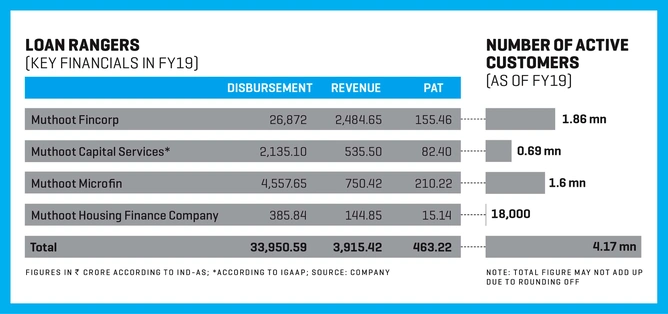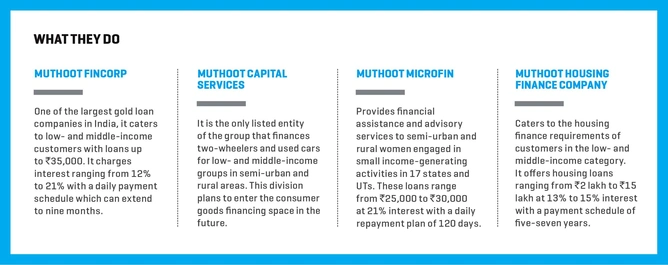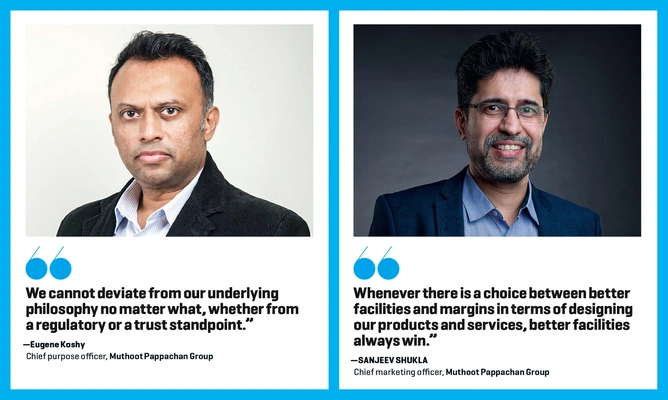The tough get going when the going gets tough. Kerala-based financial services conglomerate Muthoot Pappachan Group got the opportunity to prove the saying right last year.
In September 2018, Infrastructure Leasing & Financial Services (IL&FS) defaulted on its debt instruments, sending the entire financial sector into a tizzy. The default triggered a credit squeeze, singeing non-banking finance companies (NBFCs), even well-capitalised ones like the Pappachan group, popularly known as Blue Muthoot.
But the group, which had a turnover of ₹4,615 crore in FY19, was quick to take corrective action. “Once we realised that the credit lines were not being renewed and banks and financial institutions were asking many more questions about our business model and repayment plans, we decided to slow down our disbursements across all businesses except microfinance,” says Thomas John Muthoot, chairman and managing director, Muthoot Pappachan Group. It was not just about the credit squeeze but also about higher borrowing costs. Group companies had to fork out an additional 0.5% to its existing borrowing cost of 10.75%.
Hence, the company’s gold loans business, which was growing at 2% every month, hit zero growth in October, November, and December last year. That is when the company decided to press the hold button. “Preserving cash had become far more important than distributing it,” says the 57-year-old.
The gold loans business was soon back on track, growing 2% in February and 3% in March this year. It was the same story at its other two financing arms, the two-wheeler and low-cost housing finance businesses run by Muthoot Capital Services and Muthoot Housing Finance, respectively. But even in those challenging times its microfinance business—Muthoot Microfin—remained unaffected because banks and financial institutions continued to lend to them.
“Even during the height of the crisis we did not face any liquidity issue and fund flows were good. Ironically, we saw the largest disbursement of microfinance loans last October and November and even raised ₹500 crore from National Bank for Agriculture and Rural Development in November last year,” says Madhu Alexiouse, chief operating officer of Muthoot Capital Services, the only listed arm of the group. The microfinance division registered a healthy 53% growth in FY19 and clocked a net profit of ₹201.22 crore.
Thus, instead of clocking the targeted 24%- 25% growth in FY19, the group’s gold loans business achieved 16%, while the two-wheeler and housing loans businesses clocked 22% and 32%, respectively. Overall growth, too, slipped to 16% from the expected 24%-25%. But the group hopes to make up lost ground in FY20 despite the current economic slowdown.
This optimism is shared by Digant Haria, vicepresident, Antique Stock Broking, who believes that the group may end up “growing at 20% in FY20, but is likely to touch 24%-25% in the next two or three years”. The group, he adds, was largely unaffected by the crisis, and among the few which survived it. “Before the crisis there were some 35-40 NBFCs, which are now down to 15 or 16, which means far greater opportunities for the group,” says Haria.
Even credit rating agency CRISIL, in a recent commentary, has reaffirmed its A, or stable, rating to Muthoot Fincorp on all bank loan facilities and outstanding debt instruments. “The ratings,” says CRISIL senior director Krishnan Sitaraman, “continue to reflect promoters’ extensive experience in the loans against gold jewellery business, which accounts for around 56% of the group’s overall loan portfolio, its established market position in the business, and diversified product profile of the group”.

But how did the country’s third-largest NBFC-microfinance institution manage to buck the trend when other NBFCs and housing finance companies are either shutting shop or still reeling from the credit crunch? The answer lies in the group’s unique business model, its pan-India network of 3,600 branches mostly in semi-urban and rural areas, more than 26,000 employees and ₹19,259 crore of assets under management (AUM). A model that not only ensured that the group did not suffer from any asset-liability mismatch but continued its focus on financing retail loans to people earning ₹2 lakh- ₹10 lakh per annum. Another fact that helped the group brave the storm was diversifying into various businesses in the early 2000s. This came about because credit rating agencies had said focussing on one business exposed the group to multiple challenges.
The group’s success can also be attributed to a purpose- and value-driven workforce. To ensure that employees remain committed to the core values of the group, it appointed Eugene Koshy as chief purpose officer in November 2018. Koshy says his job is to ensure that all employees “speak the same language, engage with the customer in the same respectful way and work with a well-defined purpose that makes sense to them”. To help him in this task, the group has set up a small section in the human resources department, whose job is to keep employees in sync with the group’s vision and mission statement. “This is particularly important for a group that deals in various financial instruments and works for the economic upliftment of the sensitive low-income group of the population.”
This is the group’s strategy to keep defaults to a minimum: issue small-ticket loans to retail customers, only after Know Your Customer (KYC) documentation, for a short duration with a flexible payment schedule including early redemptions. For instance, the group has a ceiling of ₹35,000 for its 100,000-odd gold loan customers with interest rates ranging between 12% and 21%. These loans are financed and monitored by Muthoot Fincorp, with a daily payment schedule that extends up to nine months.
For women entrepreneurs running small businesses, Muthoot Microfin provides loans of ₹25,000- ₹30,000 at 21% interest with a daily repayment plan of 120 days. Today, the microfinance division is present in 17 states and Union Territories, with 1.5 million customers, 16,000 employees and ₹4,500 crore of AUM.
Providing loans to medium, small and micro enterprises (MSME) customers is the domain of the fincorp division. The loan amount varies from ₹15,000 to ₹3 lakh and can go up to ₹5 lakh, provided the customer is willing to pay monthly instalments for one or two years, depending on the amount borrowed. But for those borrowing ₹3 lakh and less, the repayment is daily, with an interest rate of 24%.

The housing finance division provides loans of ₹2 lakh to ₹15 lakh at 13%-15% interest. The average loan amount is ₹6 lakh. “We are in the space of affordable housing and our target customers—people with a salary of less than `6 lakh per annum—are ignored by the banks,” says Muthoot Housing Finance CEO Pavan K. Gupta. Most of the loans are given to those who have land and want to construct a house.
The repayment schedule of loans on a daily-, weekly-, and monthly basis; early foreclosures; and one-time settlements have helped the group avoid an asset-liability management (ALM) issue. On any day, explains Thomas John Muthoot, the group caters to nearly 75,000-100,000 customers, disburses nearly ₹100 crore and gets back ₹80 crore as repayment. “The ₹20-crore gap, which is basically for higher growth, can easily be financed. If there is a problem, we can limit the outgo to ₹80 crore so that there is no ALM mismatch.
Another reason for the low default rate is the fact that most of the employees at a branch are hired from its area of operations. Hence, everyone knows everyone. This familiarity with customers, according to the group, has helped keep defaults low, which for twowheelers is just 3%; for microfinance, 0.9%; and for housing, 2.5%.
The good thing that has emerged from the crisis, says Muthoot Microfinance CEO Sadaf Sayeed, is that capital markets and financial institutions have started “differentiating between retail NBFCs with positive ALM capable of raising capital at short notice from those in the wholesale business that have lent to stressed sectors like real estate”.
To understand the success of the group, one has to travel back more than 130 years to a grocery shop in a small, little-known village called Kozhencherry, some 100 km from Thiruvananthapuram. Run by patriarch Ninan Mathai Muthoot, it catered to the grocery needs of the sprawling British-owned tea and coffee plantations, covering some 8,000-10,000 acres and employing between 2,000 and 3,000 workers.
Once the plantation managers started paying salaries to the workers in the late 1930s and early 1940s, the grocery store diversified into a chit-fund business. Ninan Mathai Muthoot then moved into the gold loans business, which became an instant hit. “People from all over Kerala came to avail of these facilities like chit funds and gold loans,” says Thomas John Muthoot. The founder had four sons, all of whom worked in the business from a young age.

In 1979, the business was split among the founder’s three surviving sons, a process which was completed in 10 minutes. The eldest son, M. George Muthoot, moved out of Kerala and set up Muthoot Finance which has nearly 4,000 branches in the country today; the Pappachan group has 3,600 branches. “While Muthoot Finance may have more branches than us, we have many more products in our portfolio,” says Thomas John Muthoot.
Muthoot Finance, also known as The Muthoot Group, is principal team partner for the Indian Premier League team Chennai Super Kings and has actor Amitabh Bachchan as brand ambassador. After branching out from Kerala, M. George Muthoot used a red logo of two elephants standing trunk-to-trunk, with that branch of the family and its business being known as Red Muthoot.
Meanwhile, Ninan Mathai Muthoot’s youngest son Mathew M. Thomas or Muthoot Pappachan—the current chairman’s father who was then running the gold loans operations from Thiruvananthapuram—launched Muthoot Pappachan Group, with its blue branding.
“The blue colour is used to differentiate our group from the rest because all groups carry the Muthoot family name,” explains Thomas John Muthoot, who is also the chairman and MD of Muthoot Fincorp. “We have had no conflicts in the past 40 years.
and are unlikely to have any in the future despite being in similar businesses. All the groups are settled and we—the cousins—often meet informally to set interest rates for our products,” the Pappachan group chairman says.
The Pappachan group is helmed by the chairman and his two brothers: Thomas George Muthoot, who is the managing director of Muthoot Capital Services, and Thomas Muthoot, the other promoter-director of the group. The next generation is also firmly entrenched in the business: Suzannah Muthoot, the eldest daughter of Thomas Muthoot, is the zonal strategic consultant (west) of Muthoot Fincorp; Tina Suzanne George, the eldest daughter of Thomas George Muthoot, is associate vice president, finance, Muthoot Capital Services; and the chairman’s son Thomas Muthoot John is the head of the innovation lab at Muthoot Pappachan Group, and director, Muthoot Microfin.
Besides navigating the choppy waters of the sector, last year the brand transformed its motto from “Believe in Blue” to “Blue is Belief”. This was not just an indication of its coming of age, but also a growing confidence in its ability to meet its vision and mission statement. It promised to “fulfil the life-cycle needs of people at the bottom of the pyramid and help them realise their dreams and empower their hopes by being the most trusted financial provider at the doorstep”.
The group is now seeking to introduce new products. One such initiative is to bring more MSMEs into its financing fold, especially those denied loans by banks because of a low credit score or other reasons. “Whenever there is a choice between better facilities and margins in terms of designing our products and services, better facilities always win,” says Sanjeev Shukla, the group’s chief marketing officer.
Again, the growing importance of technology and customer data is not lost on the group, which has invested heavily in developing an “assisted model” to help customers learn mobile banking. “Instead of customers [doing that], we pull out all the data for them like bank details and CIBIL score and help in their financial literacy,” says Thomas John Muthoot. The group set up Muthoot Pappachan Technologies to take care of the back-end needs of all the group companies and ensure seamless connectivity among all branches. He explains the group has data on one million customers—essentially anyone who has ever used their services and products—and not just active customers. Sayeed says this data can not only be used to up-sell and cross-sell products among the same set of customers, but also to develop new products and services for their future needs. A case in point is the recently launched financing of used cars for those who aspire to move up from two-wheelers.
Haria of Antique Stock Broking believes that the company should use the current opportunity—the lack of competition—to raise equity capital of around ₹1,500 crore to ensure a sustainable 25% overall growth. “They should sell a part of their equity in the gold loans or microfinance business because raising finances through the initial public offering route at this time is not really advisable,” he adds.
Then there are other challenges of geographical concentration and asset classes. Sitaraman of CRISIL explains that since 80% of the group’s AUM is concentrated in the southern states—47% in Tamil Nadu and Kerala alone—Muthoot Fincorp is “exposed to the economic, social, and political situation in that particular region’.’
While the company has managed to grow its non-gold businesses—44% of the overall portfolio—in the past two or three years, challenges linked to asset quality remain, especially in the two-wheeler segment which is considered to be a relatively riskier one within the vehicle finance asset classes.
For Thomas John Muthoot, the most important thing in business is to be a humble person, responsible lender, and provide the right kind of advice—akin to what his personal trainer does for him. The Pappachan group chief is a fitness enthusiast. He trains for an hour and walks 6 km daily.
“Even if a person comes to us with ₹1 lakh, we sell him only 4 grams of gold jewellery [worth ₹17,052 as of October 16] because we know his family background, annual income, and understand that he wants to speculate on gold,” he explains.
“But raising my customer’s income, ensuring his economic well-being in times of stress and also helping the MSME and microfinance customers develop a sustainable business model is a real challenge and big responsibility for us,” he explains. “And I am trying to fulfil that responsibility.”
This story was originally published in the November 2019 edition of the magazine.







Leave a Comment
Your email address will not be published. Required field are marked*